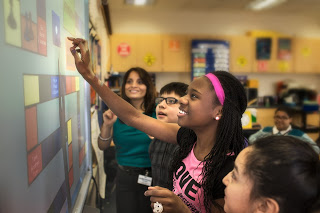Vocabulary Discussion to Teach Word Meanings
Educators and speech language pathologists are all too familiar with the myriad of activities used for teaching vocabulary, but sometimes the best way is the old-fashioned way – classroom discussion. Engaging students in active discussions about word meanings can be very rewarding.
During classroom discussion, students can learn a great deal from their peers and add to their “experiences” about the target words. Steven Stahl’s Vocabulary Development makes some good points about discussing vocabulary as a class:
Discussions can clarify misunderstandings
Give and take discussions can help students make connections about words they partially know or only knew in one context. Making these misunderstandings public allows the instructor to “shape them into conventional meaning.” Most likely, if one student misunderstands the meaning of a word, you’ve got several more students in your discussion that don’t understand it either.
Practice and Preparation
While students are waiting to be called upon, they are able to rehearse, practice and prepare their own response for the discussion. Only one child is called to answer a question or add to the discussion, but all of the students around him are practicing what they might say and are thinking about what they know about the vocabulary word. This act of students practicing “covertly” can lead to increased vocabulary learning and a deeper and broader understanding of the word.
Using the Text
Research has shown that learning words in text improves comprehension. It’s recommended teachers should chose the words for discussion that are important to the text. For example, if the class is reading Lois Lowry’s Number the Stars and comes across the sentence, “Kristi dawdled just behind them or scampered ahead, never out of sight,” two of the words give context into Kristi’s motive or emotion. Dawdle is walking slowly, gently or powerfully, and means the character is oblivious or wasting time. Students can discuss how dawdle and scamper provide added inferential information and give insight into why Kristi is walking in such a way.
Experiences
Classroom discussion or even one-on-one discussion, can provide the student with added experiences that help them recall the meaning of the word. When trying to recall what a word means while reading or taking a test, the previous discussion might trigger associations to help with word retrieval. “Oh, yeah, I remember we talked about that in class and Jake said….” or “it was really funny when Ashley said ___ about this word.”
Technology and Classroom Discussion
Finally, some schools in our area us smart board technology during classroom discussion. The instructor uses computers and tablets hooked up to a large screen that acts like a large classroom tablet. You display the app or program on the board and then teachers and students can touch the board like a tablet or phone to interact with the software. Our iPad vocabulary apps, InferCabulary and WordQuations, have been used with smart board technology and some pretty amazing discussions arose in this classroom exercise. With InferCabulary we’ve heard, “No, prominent can’t just mean sticking out like that tree, because you see that picture of a green eye?” WordQuations really lends itself to helping students make connections using an “equation” to determine the meaning of verb synonyms along with vine-like videos.
Low tech and high tech classroom discussions are important for students to understand new and lesser-known vocabulary words words in a deeper and broader way.



